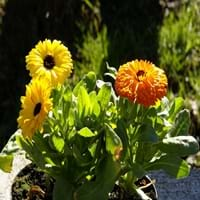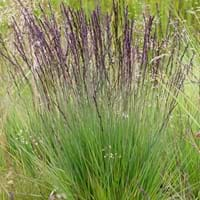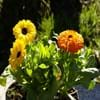Life Span
Perennial
Perennial
Type
Flowering Plants
Grass
Origin
Europe, Mediterranean
Asia, Europe, North Africa
Types
Kablouna Gold, Fiesta Gitana, Art Shades
purple moor-grass 'Moorhexe', variegated purple moor-grass
Habitat
gardens, Roadsides, Waste areas, wastelands
Boggy areas, Dry and Young forest Heaths, Lowland
USDA Hardiness Zone
3-9
4-8
AHS Heat Zone
6 - 1
9 - 1
Sunset Zone
A2, A3, H1, 1a, 1b, 2a, 2b, 3a, 3b, 4, 5, 6, 7, 8, 9, 10, 11, 12, 13, 14, 15, 16, 17, 18, 19, 20, 21, 22, 23, 24
1a, 1b, 2a, 2b, 3a, 3b, 4, 5, 6, 7, 8, 9, 14, 15, 16, 17
Habit
Clump-Forming
Clump-Forming
Flower Color
Yellow, Orange, Bronze, Ivory
Dark Purple
Flower Color Modifier
Bicolor
Bicolor
Fruit Color
Green, Tan
Non Fruiting Plant
Leaf Color in Spring
Green
Green, Dark Green
Leaf Color in Summer
Green
Light Green
Leaf Color in Fall
Green
Green, Yellow green, Gold
Leaf Color in Winter
Light Green
Tan
Leaf Shape
Oblong-lanceolate
Needle like
Plant Season
Early Autumn, Spring, Summer
Spring, Summer, Fall, Winter
Sunlight
Full Sun, Partial shade, Partial Sun
Full Sun, Partial Sun
Type of Soil
Well drained
Clay, Loam, Sand
The pH of Soil
Acidic, Alkaline, Neutral
Acidic, Neutral
Soil Drainage
Average
Average
Bloom Time
Early Winter
Late Spring, Summer, Late Summer, Early Fall, Fall
Tolerances
Drought
Not Available
Where to Plant?
Ground, Pot
Ground, Pot
How to Plant?
Seedlings, Transplanting
Divison, Transplanting, Vegetative Reproduction
Plant Maintenance
Medium
Low
Watering Requirements
Requires regular watering
Requires regular watering, Water more frequently during periods of extreme drought
In Summer
Lots of watering
Lots of watering
In Spring
Moderate
Moderate
In Winter
Average Water
Average Water
Soil pH
Acidic, Alkaline, Neutral
Acidic, Neutral
Soil Type
Moist, Well drained
Clay, Loam, Sand
Soil Drainage Capacity
Not Available
Average
Sun Exposure
Partial shade
Full Sun, Partial Sun
Pruning
Cut or pinch the stems, Remove damaged leaves, Remove dead branches, Remove dead leaves
Prune in winter, Remove damaged leaves, Remove dead branches, Remove dead leaves
Fertilizers
All-Purpose Liquid Fertilizer
No need to fertilize every year
Pests and Diseases
Red blotch
Pests and diseases free
Plant Tolerance
Drought
Not Available
Flower Petal Number
Double, Semi-Double
Single
Foliage Texture
Medium
Fine
Foliage Sheen
Matte
Matte
Attracts
Beetles, Butterflies, Flying insects
Not Available
Allergy
Dizziness, Itchiness, Nausea, Skin rash, Swelling
Not Available
Aesthetic Uses
Showy Purposes
Showy Purposes, Water gardening
Beauty Benefits
Good for skin and hair, Skin cleanser, Skin Problems, used as a dye
Not Available
Environmental Uses
Air purification
No fertilizer, pesticides, or herbicides needed
Medicinal Uses
Curing mumps and measles, Cuts, Reduces toothache, Surgical wounds, Throat infection, Ulcers
No Medicinal Use
Part of Plant Used
Flowers, Leaves, Root
Whole plant
Other Uses
Cosmetics, Sometimes used for making wine, Used as an insecticide, Used as essential oil, Used As Food, Used as Ornamental plant, Used in salads
Used as Ornamental plant
Used As Indoor Plant
Insignificant
No
Used As Outdoor Plant
Yes
Yes
Garden Design
Groundcover, Showy Tree
Container, Foundation, Mixed Border
Botanical Name
CALENDULA officinalis
Molinia caerulea
Common Name
Pot Marigold
purple moor-grass
In Hindi
Pot Marigold
बैंगनी दलदल घास
In German
Ringelblume
Pfeifengras
In French
pot Marigold
pourpre lande-grass
In Spanish
Caléndula
púrpura amarra-hierba
In Greek
καλέντουλα
μωβ Moor-γρασίδι
In Portuguese
pot Marigold
purple moor-grass
In Polish
Pot Marigold
fioletowy Moor-trawa
In Latin
Zinnia Pot
Maurus herba-purpura,
Phylum
Vascular plant
Magnoliophyta
Class
Magnoliopsida
Liliopsida
Order
Asterales
Cyperales
Family
Asteraceae
Poaceae
Clade
Angiosperms, Asterids, Eudicots
Angiosperms, Commelinids, Monocots
Tribe
Calenduleae
Not Available
Subfamily
Asteroideae
Not Available
Number of Species
Not Available
Importance of Pot Marigold and Molinia Caerulea
Want to have the most appropriate plant for your garden? You might want to know the importance of Pot Marigold and Molinia Caerulea. Basically, these two plants vary in many aspects. Compare Pot Marigold and Molinia Caerulea as they differ in many characteristics such as their life, care, benefits, facts, etc. Every gardener must at least have the slightest clue about the plants he wants to plant in his garden. Compare their benefits, which differ in many ways like facts and uses. The medicinal use of Pot Marigold is Curing mumps and measles, Cuts, Reduces toothache, Surgical wounds, Throat infection and Ulcers whereas of Molinia Caerulea is No Medicinal Use. Pot Marigold has beauty benefits as follows: Good for skin and hair, Skin cleanser, Skin Problems and used as a dye while Molinia Caerulea has beauty benefits as follows: Good for skin and hair, Skin cleanser, Skin Problems and used as a dye.
Compare Facts of Pot Marigold vs Molinia Caerulea
How to choose the best garden plant for your garden depending upon its facts? Here garden plant comparison will help you to solve this query. Compare the facts of Pot Marigold vs Molinia Caerulea and know which one to choose. As garden plants have benefits and other uses, allergy is also a major drawback of plants for some people. Allergic reactions of Pot Marigold are Dizziness, Itchiness, Nausea, Skin rash and Swelling whereas of Molinia Caerulea have Not Available respectively. Having a fruit bearing plant in your garden can be a plus point of your garden. Pot Marigold has no showy fruits and Molinia Caerulea has showy fruits. Also Pot Marigold is flowering and Molinia Caerulea is not flowering . You can compare Pot Marigold and Molinia Caerulea facts and facts of other plants too.





